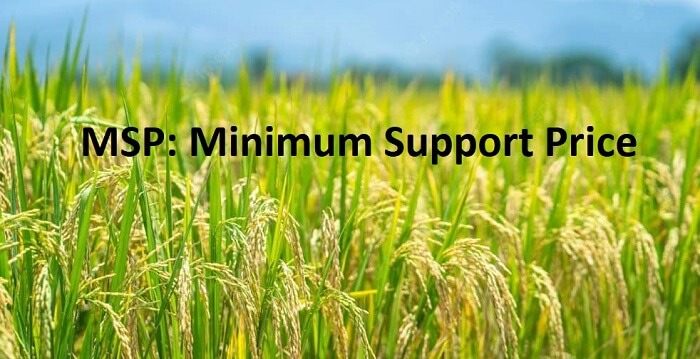What is the full form of MSPMSP: Minimum Support PriceMSP stands for Minimum Support Price. The Indian government uses the MSP (Minimum Support Price) as a kind of market tool to protect farmers from a sudden drop in farm prices. On the basis of the report of the CACP (Commission for Agricultural Costs and Prices), the Government of India announces the minimum support prices at the beginning of the season of sowing seeds for several crops. 
MSP is a price set by the Indian government to protect farmers, who are the producers, against a sharp decline in price during years of bumper crop production. The minimum support prices serve as the guaranteed price by the government to the producer for their produce. The main goals are to buy food grains for public distribution and to support farmers who are having to sell their crops at a loss. Government agencies buy the entire amount given by the farmers at the declared minimum price in the event that the market price for the product falls below the announced minimum price as a result of a large crop and market surplus. MSP's Historical PerspectiveThe government's price support policy aims to protect agricultural producers from any significant drops in farm prices. In order to create a ceiling above which market prices cannot fall, the minimum guaranteed prices are fixed. Up to the middle of the 1970s, the government published two categories of administered prices. Purchasing Prices Minimum Support Prices (MSP)The MSPs were set by the government as a long-term guarantee for producers' investment choices, providing them with the security that the prices of their commodities would not be permitted to fall below the level set by the government, even in the event of a good crop. The MSPs served as the floor prices. The prices of Kharif and Rabi cereals at which the grain was to be domestically purchased by public organisations (like the FCI) for release through PDS were known as procurement prices. It was made public not long after harvest started. Typically, the procurement price was higher than the MSP and lower than the open market price. In the case of paddy, this strategy of having two official prices declared continued with some modifications up until 1973-1974. In the case of wheat, it was eliminated in 1969 and then briefly resumed in 1974-1975. The current approach, in which just one set of pricing was issued for paddy (and other Kharif crops) and wheat being purchased for buffer stock operations, was developed in 1975-1976 due to an excessive number of requests for increasing the MSP. Calculation of MSPIn addition to taking into account the complete economic structure of a given item or group of commodities, the Commission also considers the following elements when formulating recommendations for the level of minimum support prices and other non-price measures:
The rise in MSP for Kharif Crops is in accordance with the promise made in the Union Budget 2018-19 that the MSPs will be set at a level of at least 1.5 times the All-India weighted average Cost of Production (CoP), seeking to provide fairly just compensation for the farmers. The Price Structure For SugarcaneThe Essential Commodities Act (ECA), 1955's statutory provisions, which were issued as the Sugarcane (Control) Order, 1966, govern sugarcane prices. The Central Government set the Statutory Minimum Price (SMP) of sugarcane prior to the 2009-10 sugar season, and farmers were allowed to split the earnings of a sugar mill 50:50. The Sugarcane (Control) Order, 1966 was changed in October 2009, replacing the idea of SMP with the Fair and Remunerative Price (FRP) of sugarcane, as this profit-sharing remained essentially unimplemented. With effect for the 2009-10 sugar season, a new clause named "fair margins for growers of sugarcane on account of risk and earnings" was included as an extra account when determining FRP. Therefore, the CACP must give the statutory considerations specified in the Control Order, which include
Next TopicFull Form
|
 For Videos Join Our Youtube Channel: Join Now
For Videos Join Our Youtube Channel: Join Now
Feedback
- Send your Feedback to [email protected]
Help Others, Please Share










